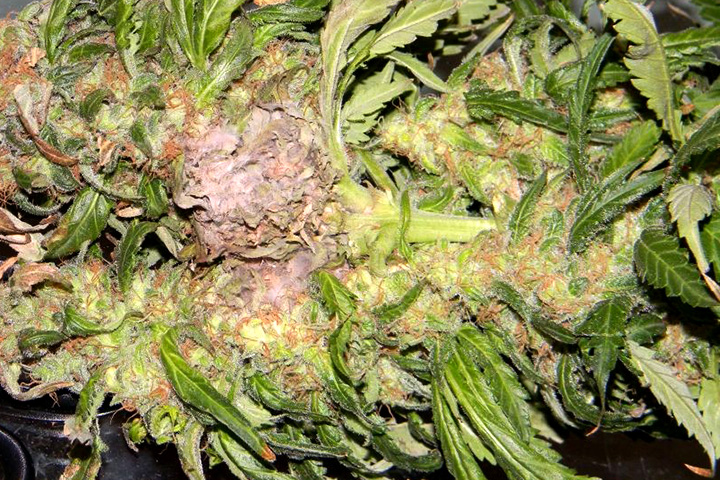
Gray Mold And Your Marijuana Plants
Some marijuana growers would argue that it’s the most dangerous risk to a marijuana garden. Because of this danger, it’s important to know exactly how to prevent it before it strikes. Keep reading to find out more about gray mold and how to stop it before it starts.
This article covers:
Gray mold facts
Detecting a gray mold problem
How to prevent gray mold
How to treat gray mold
Gray mold facts
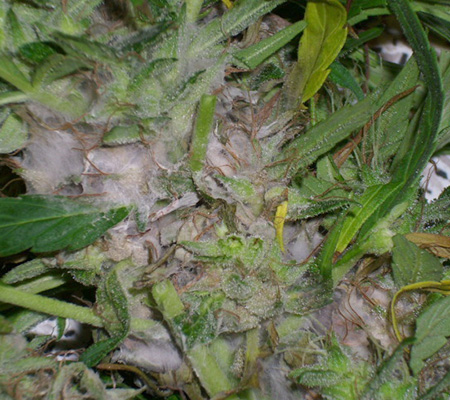
One aspect of gray mold that makes it a tricky foe is the fact that it is not picky with its attacks. It will go for old and young plants, buds and seeds alike. It thrives in climates that are cool and humid. It destroys all sorts of plants (not just marijuana) from the inside out. So what exactly is gray mold, and how can it infest your marijuana garden?
Simply put, gray mold is a fungus that goes by the name of Botrytis cinerea. It travels via spores through the wind or water, and it starts attacking plants that it physically comes in contact with. The spores travel quickly and easily, and they get inside your plants via a tear in its flesh. Plants that have been trained often have cracks in their stems, and any plants that have been affected by pests might have “wounds” through which gray mold can travel. More gray mold in my free grow bible.
Detecting a gray mold problem
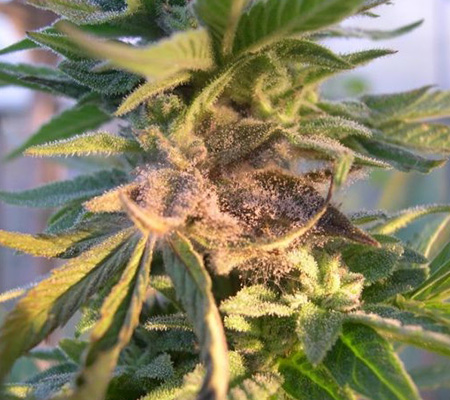
You will start to notice the effects of gray mold when your plant’s stem begins browning and softening -- this signifies that they have begun to rot. The stems will flop over (called “damping off”) and there might be a gray mass that appears first. Then fungal spores begin appearing and soon your plant will be deprived of chlorophyll, causing it to yellow.
If your plants are female and budding, this is the next step in the fungus’ journey. It moves from step to buds, and the pistils will begin to brown and wilt shortly after the leaves do. The buds will be carpeted with gray mycelium and won’t be good for harvesting. Most people realize they have a gray mold problem once parts of their plants are already dead.
Keep a close eye on your buds to catch gray mold as early as possible. You will first see gray mold as a powdery white substance that will turn brown or darker gray -- this color as well as other colors might appear. If you see this, the damage has already begun to ruin your plant or bud.
How to prevent gray mold
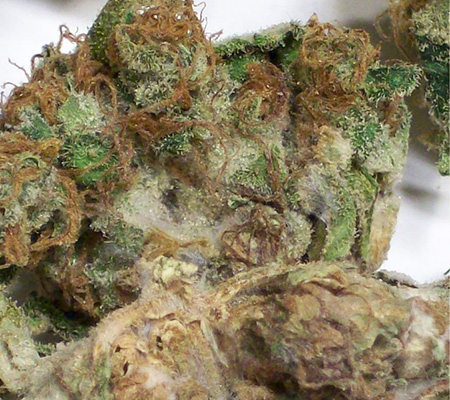
Make sure that the environment your plants are growing in is warm, dry, and well ventilated. As long as there is a nice breeze and warm temperatures (70 degrees Fahrenheit), your plants are already starting out ahead. If you can actually see that your marijuana plants are moist, then the environment is too humid and needs to be adjusted -- 50% or lower humidity is perfect. For outdoor growers, these things are unfortunately uncontrollable. You can, however, prune your plants to make sure they’re not too dense, allowing for plenty of airflow through their leaves.
Practice good hygiene in a variety of ways, such as changing your clothes before going into the grow room or to your outdoor garden. That way, it is much less likely for the spores to travel on your clothes into the grow room. Don’t allow the house pet in, and keep shears and other gardening tools sanitized.
Make sure you are allowing your marijuana plants to dry out enough to not retain any excess moisture. You can do this by watering them during the day, therefore giving them several hours of daylight to dry off afterwards -- having moist plants when it’s dark is the perfect time for gray mold to start to grow.
Download my free marijuana grow guide and learn more about gray mold
If you want to be more proactive in order to avoid a gray mold problem, use a spray such as bacillus subtilis or an oil-based spray, like neem oil or sesame oil. This forms a sort of shield against the development of mold. Potassium Bicarbonate will do the same thing.
Awareness of your plants’ conditions in detail is key to both prevention and early treatment. Be especially aware when the weather is cool and rainy, or block the rain by hanging a tarp over your plants when there is rain in the forecast. You can also just shake each plant, one by one, after a rain so that they don’t sit in the moisture for too long.
How to treat gray mold
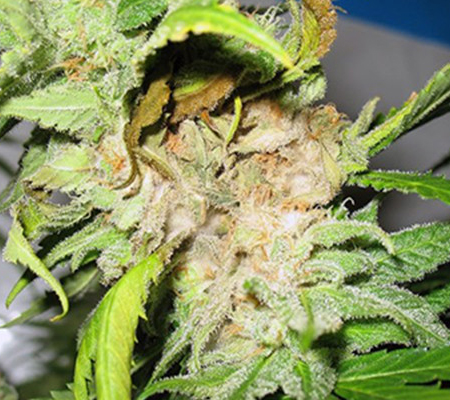
If one or more of your plants have been strongly affected by gray mold, it’s time to cut your losses and remove the entire plant before it spreads to the other ones. Take out every bit of the plant and place it in a sealed plastic bag before throwing it away. Don’t add them to your compost pile, as that would cause the gray mold to spread back to your plants with ease.
If only part of the plant is affected, you can attempt the pruning route -- remove all the leaves and buds that have been affected, and then sterilize the pruners you used with rubbing alcohol or peroxide.
Another way to treat plants affected by gray mold is to apply a copper sulfate and slaked line bordeaux mixture. Plenty of gardeners and farmers use this to prevent their non-marijuana plants from contracting gray mold, especially in vineyards. Otherwise try using copper soap or spray, which is harmless to the harvest and can be used from day one of your plants’ lives. Spray it on them every week or week and a half. Another option is to utilize sulfur burners or sprays so that the treatment isn’t just sitting on the plant, but also works through the air.
One thing to note is that you shouldn’t use fungicide of any sort if your plants are budding, and don’t spray the buds with neem oil or burn sulfur during the flowering phase. If your buds end up tasting terrible, then all is lost in any case -- and that’s what spraying them with these products will do.
Thanks for reading. Please leave comments or questions below and don’t forget to download my free grow bible.